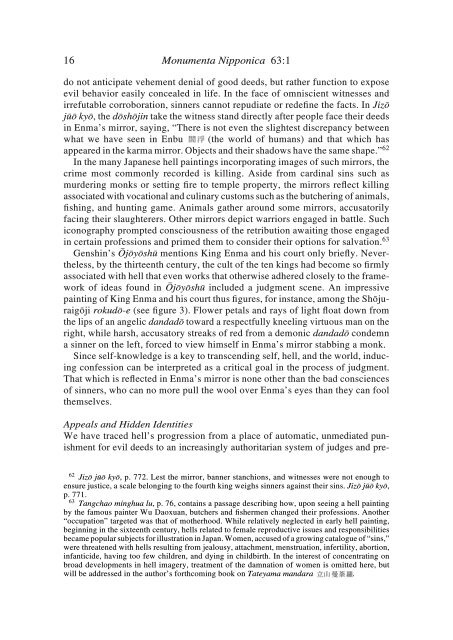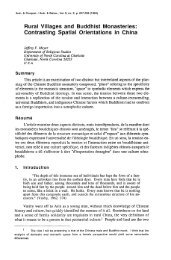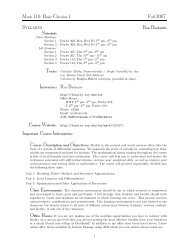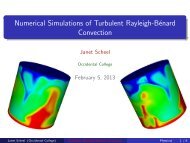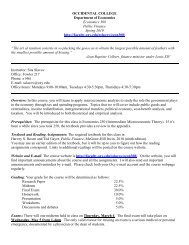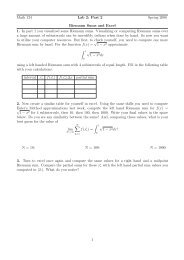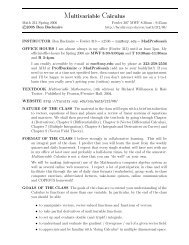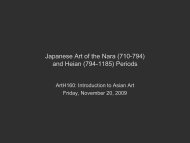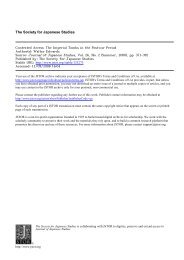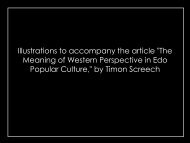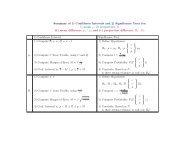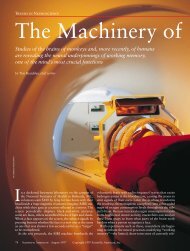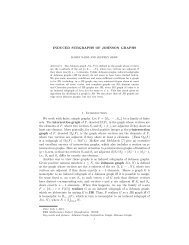A Primer on Japanese Hell Imagery and Imagination - Occidental ...
A Primer on Japanese Hell Imagery and Imagination - Occidental ...
A Primer on Japanese Hell Imagery and Imagination - Occidental ...
You also want an ePaper? Increase the reach of your titles
YUMPU automatically turns print PDFs into web optimized ePapers that Google loves.
16<br />
M<strong>on</strong>umenta Nipp<strong>on</strong>ica 63:1<br />
do not anticipate vehement denial of good deeds, but rather functi<strong>on</strong> to expose<br />
evil behavior easily c<strong>on</strong>cealed in life. In the face of omniscient witnesses <strong>and</strong><br />
irrefutable corroborati<strong>on</strong>, sinners cannot repudiate or redefine the facts. In Jizô<br />
jûô kyô, the dôshôjin take the witness st<strong>and</strong> directly after people face their deeds<br />
in Enma’s mirror, saying, “There is not even the slightest discrepancy between<br />
what we have seen in Enbu (the world of humans) <strong>and</strong> that which has<br />
appeared in the karma mirror. Objects <strong>and</strong> their shadows have the same shape.” 62<br />
In the many <strong>Japanese</strong> hell paintings incorporating images of such mirrors, the<br />
crime most comm<strong>on</strong>ly recorded is killing. Aside from cardinal sins such as<br />
murdering m<strong>on</strong>ks or setting fire to temple property, the mirrors reflect killing<br />
associated with vocati<strong>on</strong>al <strong>and</strong> culinary customs such as the butchering of animals,<br />
fishing, <strong>and</strong> hunting game. Animals gather around some mirrors, accusatorily<br />
facing their slaughterers. Other mirrors depict warriors engaged in battle. Such<br />
ic<strong>on</strong>ography prompted c<strong>on</strong>sciousness of the retributi<strong>on</strong> awaiting those engaged<br />
in certain professi<strong>on</strong>s <strong>and</strong> primed them to c<strong>on</strong>sider their opti<strong>on</strong>s for salvati<strong>on</strong>. 63<br />
Genshin’s Ôjôyôshû menti<strong>on</strong>s King Enma <strong>and</strong> his court <strong>on</strong>ly briefly. Nevertheless,<br />
by the thirteenth century, the cult of the ten kings had become so firmly<br />
associated with hell that even works that otherwise adhered closely to the framework<br />
of ideas found in Ôjôyôshû included a judgment scene. An impressive<br />
painting of King Enma <strong>and</strong> his court thus figures, for instance, am<strong>on</strong>g the Shôjuraigôji<br />
rokudô-e (see figure 3). Flower petals <strong>and</strong> rays of light float down from<br />
the lips of an angelic d<strong>and</strong>adô toward a respectfully kneeling virtuous man <strong>on</strong> the<br />
right, while harsh, accusatory streaks of red from a dem<strong>on</strong>ic d<strong>and</strong>adô c<strong>on</strong>demn<br />
a sinner <strong>on</strong> the left, forced to view himself in Enma’s mirror stabbing a m<strong>on</strong>k.<br />
Since self-knowledge is a key to transcending self, hell, <strong>and</strong> the world, inducing<br />
c<strong>on</strong>fessi<strong>on</strong> can be interpreted as a critical goal in the process of judgment.<br />
That which is reflected in Enma’s mirror is n<strong>on</strong>e other than the bad c<strong>on</strong>sciences<br />
of sinners, who can no more pull the wool over Enma’s eyes than they can fool<br />
themselves.<br />
Appeals <strong>and</strong> Hidden Identities<br />
We have traced hell’s progressi<strong>on</strong> from a place of automatic, unmediated punishment<br />
for evil deeds to an increasingly authoritarian system of judges <strong>and</strong> pre-<br />
62 Jizô jûô kyô, p. 772. Lest the mirror, banner stanchi<strong>on</strong>s, <strong>and</strong> witnesses were not enough to<br />
ensure justice, a scale bel<strong>on</strong>ging to the fourth king weighs sinners against their sins. Jizô jûô kyô,<br />
p. 771.<br />
63 Tangchao minghua lu, p. 76, c<strong>on</strong>tains a passage describing how, up<strong>on</strong> seeing a hell painting<br />
by the famous painter Wu Daoxuan, butchers <strong>and</strong> fishermen changed their professi<strong>on</strong>s. Another<br />
“occupati<strong>on</strong>” targeted was that of motherhood. While relatively neglected in early hell painting,<br />
beginning in the sixteenth century, hells related to female reproductive issues <strong>and</strong> resp<strong>on</strong>sibilities<br />
became popular subjects for illustrati<strong>on</strong> in Japan. Women, accused of a growing catalogue of “sins,”<br />
were threatened with hells resulting from jealousy, attachment, menstruati<strong>on</strong>, infertility, aborti<strong>on</strong>,<br />
infanticide, having too few children, <strong>and</strong> dying in childbirth. In the interest of c<strong>on</strong>centrating <strong>on</strong><br />
broad developments in hell imagery, treatment of the damnati<strong>on</strong> of women is omitted here, but<br />
will be addressed in the author’s forthcoming book <strong>on</strong> Tateyama m<strong>and</strong>ara .


